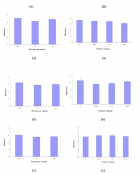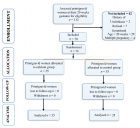Abstract
Research Article
The secondary metabolites profiling of the phytopathogenic fungus Sclerotinia Sclerotiorum
Sarah Otun*, Ikechukwu Achilonu and Khayalethu Ntushelo
Published: 10 June, 2023 | Volume 7 - Issue 2 | Pages: 027-038
Sclerotinia sclerotiorum is a necrotrophic plant pathogen causing more than 60 different disease symptoms in approximately 400 plants globally. Hence, due to this distinctive characteristic, S. sclerotiorum has been the subject of various research to comprehend its pathogenicity mechanism, including virulent genes, proteins, and metabolites. Likewise, the genomic annotation of S. sclerotiorum uncovered its remarkable potential for producing secondary metabolites, of which genome mining has additionally prompted the disclosure of these uncharacterized metabolic pathways, which might aid the pathogenicity process. To comprehend the secondary metabolites secreted by S. sclerotiorum that might be involved in its pathogenicity, a secondary metabolite-level investigation of this plant pathogen was performed. Profiling and characterizing these secondary metabolites produced during in vitro germination would increase the current knowledge of this pathogen.
In this study, S. sclerotiorum secondary metabolites profile examination was conducted, utilizing the Ultra-High Resolution Qq-Time-Of-Flight mass spectrometer (UHR-QqTOF). Proficient data analysis and verification with the genomic pathways of S. sclerotiorum gave an unequivocal metabolome profile of this pathogen. Two hundred and thirty secondary metabolites were identified in all three biological replicates, and their bodily functions were identified.
Read Full Article HTML DOI: 10.29328/journal.jpsp.1001102 Cite this Article Read Full Article PDF
Keywords:
Sclerotinia sclerotiorum; Secondary metabolites; Metabolic pathways; Pathogenicity; Virulence factors
References
- Purdy LH. Symposium on Sclerotinia sclerotiorum: History, Diseases and Symptomatology, Host Range, Geographic Distribution, and Impact. Phytopathology. 1979; 69(8):875–80.
- Rahman MME, Suzuki K, Islam MM, Dey TK, Harada N, Hossain DM. Molecular characterisation, mycelial compatibility grouping, and aggressiveness of a newly emerging phytopathogen, Sclerotinia sclerotiorum, causing white mould disease in new host crops in Bangladesh. Journal of Plant Pathology. 2020; 102(3):775–85.
- Gupta T, Kumari C, Vanshika, Kulshrestha S. Biology and mycovirus-assisted biological control of Sclerotinia sclerotiorum infecting vegetable and oilseed crops. Archives of Phytopathology and Plant Protection. 2019; 52(13-14):1049–67.
- Hossain MM, Sultana F, Li W, Tran LP, Mostofa MG. Sclerotinia sclerotiorum(Lib.) de Bary: Insights into the Pathogenomic Features of a Global Pathogen. Cells. 2023 Mar 31;12(7):1063. doi: 10.3390/cells12071063. PMID: 37048136; PMCID: PMC10093061.
- Tian J, Chen C, Sun H, Wang Z, Steinkellner S, Feng J, Liang Y. Proteomic Analysis Reveals the Importance of Exudates on Sclerotial Development in Sclerotinia sclerotiorum. J Agric Food Chem. 2021 Feb 3;69(4):1430-1440. doi: 10.1021/acs.jafc.0c06685. Epub 2021 Jan 22. PMID: 33481591.
- Otun S, Ntushelo K. How to Knock down a Plant; the Three Weapons of Sclerotinia sclerotiorum. Journal of Biological Sciences. 2019; 19(4):300–13.
- Otun S, Ntushelo K. Proteomic analysis of the phytogenic fungus Sclerotinia sclerotiorum. J Chromatogr B Analyt Technol Biomed Life Sci. 2020 May 1;1144:122053. doi: 10.1016/j.jchromb.2020.122053. Epub 2020 Mar 14. PMID: 32229427.
- Zamani-Noor N. Baseline Sensitivity and Control Efficacy of Various Groups of Fungicides against Sclerotinia sclerotiorum in Oilseed Rape Cultivation. Agronomy. 2021; 11(9):1758.
- Albert D, Dumonceaux T, Carisse O, Beaulieu C, Filion M. Combining Desirable Traits for a Good Biocontrol Strategy against Sclerotinia sclerotiorum. Microorganisms. 2022 Jun 9;10(6):1189. doi: 10.3390/microorganisms10061189. PMID: 35744707; PMCID: PMC9228387.
- Verma PP, Shelake RM, Das S, Sharma P, Kim JY. Plant Growth-Promoting Rhizobacteria (PGPR) and Fungi (PGPF): Potential Biological Control Agents of Diseases and Pests. In: Microbial Interventions in Agriculture and Environment. Singapore: Springer Singapore. 2019; 281–311.
- Singh Saharan G, Mehta NK, Meena PD. Future Research Priorities of Crucifers’ Host-Pathosystem. In: Genomics of Crucifer’s Host- Pathosystem. Singapore: Springer Nature Singapore. 2023; 915–21.
- Tian J, Chen C, Sun H, Wang Z, Steinkellner S, Feng J. Proteomic Analysis Reveals the Importance of Exudates on Sclerotial Development in Sclerotinia sclerotiorum. J Agric Food Chem [Internet]. 2021 Feb 3 [cited 2023 Jan 12];69(4):1430–40. https://pubs.acs.org/doi/full/10.1021/acs.jafc.0c06685
- Zuo R, Xie M, Gao F, Sumbal W, Cheng X, Liu Y, Bai Z, Liu S. The Characterization of the Phloem Protein 2Gene Family Associated with Resistance to Sclerotinia sclerotiorum in Brassica napus. Int J Mol Sci. 2022 Apr 1;23(7):3934. doi: 10.3390/ijms23073934. PMID: 35409295; PMCID: PMC8999561.
- Li M, Tang Y, Yu M, Fan Y, Khan SU, Chang W. Systematic Characterisation of Brassica napus HIR Gene Family Reveals a Positive Role of BnHIR2.7 in Sclerotinia sclerotiorum Resistance. Horticulturae [Internet]. 2022 Oct 1 [cited 2023 Jan 12];8(10):874. https://www.mdpi.com/2311-7524/8/10/874/htm
- Thaning C, Welch CJ, Borowicz JJ, Hedman R, Gerhardson B. Suppression of Sclerotinia sclerotiorum apothecial formation by the soil bacterium Serratia plymuthica: identification of a chlorinated macrolide as one of the causal agents. Soil Biol Biochem. 2001; 33(12–13):1817–26.
- Li H, Cai Y, Guo Y, Chen F, Zhu ZJ. MetDIA: Targeted Metabolite Extraction of Multiplexed MS/MS Spectra Generated by Data-Independent Acquisition. Anal Chem. 2016 Sep 6;88(17):8757-64. doi: 10.1021/acs.analchem.6b02122. Epub 2016 Aug 8. PMID: 27462997.
- Bang KW. Investigation of plant and fungi-derived natural products for application as antimicrobial aerosols. 2020 [cited 2023 Jan 12]; https://researchspace.auckland.ac.nz/handle/2292/54253
- Zhang J, Lu Q, Xin L, Lou Y, Xiao W, Wang Z, Zhao L, Xiong Z. A liquid chromatography-mass spectrometry untargeted urinary metabonomics combined with quantitative analysis of seven amino acids biomarkers on yaobitong capsule in the intervention of rheumatoid arthritis rats. J Sep Sci. 2022 Dec;45(23):4209-4223. doi: 10.1002/jssc.202200654. Epub 2022 Oct 17. PMID: 36200630.
- Ridder L, van der Hooft JJ, Verhoeven S. Automatic Compound Annotation from Mass Spectrometry Data Using MAGMa. Mass Spectrom (Tokyo). 2014;3(Spec Iss 2):S0033. doi: 10.5702/massspectrometry.S0033. Epub 2014 Jul 2. PMID: 26819876; PMCID: PMC4321337.
- Kanehisa M, Araki M, Goto S, Hattori M, Hirakawa M, Itoh M, Katayama T, Kawashima S, Okuda S, Tokimatsu T, Yamanishi Y. KEGG for linking genomes to life and the environment. Nucleic Acids Res. 2008 Jan;36(Database issue):D480-4. doi: 10.1093/nar/gkm882. Epub 2007 Dec 12. PMID: 18077471; PMCID: PMC2238879.
- Chong J, Wishart DS, Xia J. Using MetaboAnalyst 4.0 for Comprehensive and Integrative Metabolomics Data Analysis. Curr Protoc Bioinformatics. 2019 Dec;68(1):e86. doi: 10.1002/cpbi.86. PMID: 31756036.
- Xia S, Xu Y, Hoy R, Zhang J, Qin L, Li X. The Notorious Soilborne Pathogenic Fungus Sclerotinia sclerotiorum: An Update on Genes Studied with Mutant Analysis. Pathogens. 2019 Dec 27;9(1):27. doi: 10.3390/pathogens9010027. PMID: 31892134; PMCID: PMC7168625.
- Maximiano MR, Miranda VJ, de Barros EG, Dias SC. Validation of an in vitro system to trigger changes in the gene expression of effectors of Sclerotinia sclerotiorum. J Appl Microbiol. 2021 Aug;131(2):885-897. doi: 10.1111/jam.14973. Epub 2021 Jan 4. PMID: 33331046.
- Can H, Kal U, Kayak N, Dal Y, Turkmen O. Use of microbial inoculants against biotic stress in vegetable crops: physiological and molecular aspect. In: Sustainable Horticulture. Elsevier; 2022; 263–332.
- Garrido-Arandia M, Silva-Navas J, Ramírez-Castillejo C, Cubells-Baeza N, Gómez-Casado C, Barber D, Pozo JC, Melendi PG, Pacios LF, Díaz-Perales A. Characterisation of a flavonoid ligand of the fungal protein Alt a 1. Sci Rep. 2016 Sep 16;6:33468. doi: 10.1038/srep33468. PMID: 27633190; PMCID: PMC5025882.
- Ciubotaru RM, Garcia-Aloy M, Masuero D, Franceschi P, Zulini L, Stefanini M, Oberhuber M, Robatscher P, Chitarrini G, Vrhovsek U. Semi-Targeted Profiling of the Lipidome Changes Induced by Erysiphe Necatorin Disease-Resistant and Vitis vinifera Varieties. Int J Mol Sci. 2023 Feb 17;24(4):4072. doi: 10.3390/ijms24044072. PMID: 36835477; PMCID: PMC9958630.
- Watters DJ. Ascidian Toxins with Potential for Drug Development. Marine Drugs 2018, Vol 16, Page 162 [Internet]. 2018 May 13 [cited 2023 Jan 12];16(5):162. https://www.mdpi.com/1660-3397/16/5/162/htm
- Pascall M, Lee K. Food Regulations in the United States. Nutrition: An Approach to Good Health and Disease Management.]. 2016 [cited 2023 Jan 12];21.: https://books.google.com/books?hl=en&lr=&id=udrnDQAAQBAJ&oi=fnd&pg=PA21&dq=studies+have+demonstrated+that+many+polyketides,+whose+backbones+are+often+frequently+changed+by+glycosylation+or+oxidation,+e.g,+erythromycins,+tetracyclines,+avermectins,+are+commonly+utilized+anti-microbial,+anti-parasitic+and+anti-cancer+and+antitumor+&ots=Xz9T-tZ9Tl&sig=Cw8gfLR8x60ysDXmvNu3FwVILe4
- Seifbarghi S, Borhan MH, Wei Y, Coutu C, Robinson SJ, Hegedus DD. Changes in the Sclerotinia sclerotiorum transcriptome during infection of Brassica napus. BMC Genomics. 2017 Mar 29;18(1):266. doi: 10.1186/s12864-017-3642-5. PMID: 28356071; PMCID: PMC5372324.
- Ranjan A, Westrick NM, Jain S, Piotrowski JS, Ranjan M, Kessens R, Stiegman L, Grau CR, Conley SP, Smith DL, Kabbage M. Resistance against Sclerotinia sclerotiorum in soybean involves a reprogramming of the phenylpropanoid pathway and up-regulation of antifungal activity targeting ergosterol biosynthesis. Plant Biotechnol J. 2019 Aug;17(8):1567-1581. doi: 10.1111/pbi.13082. Epub 2019 Feb 11. PMID: 30672092; PMCID: PMC6662107.
- McCommis KS, Finck BN. Mitochondrial pyruvate transport: a historical perspective and future research directions. Biochem J. 2015 Mar 15;466(3):443-54. doi: 10.1042/BJ20141171. PMID: 25748677; PMCID: PMC4464838.
- Nikolaivits E, Pantelic B, Azeem M, Taxeidis G, Babu R, Topakas E, Brennan Fournet M, Nikodinovic-Runic J. Progressing Plastics Circularity: A Review of Mechano-Biocatalytic Approaches for Waste Plastic (Re)valorization. Front Bioeng Biotechnol. 2021 Jun 22;9:696040. doi: 10.3389/fbioe.2021.696040. PMID: 34239864; PMCID: PMC8260098.
- Chhatwal AR, Lomax HV, Blacker AJ, Williams JMJ, Marcé P. Direct synthesis of amides from nonactivated carboxylic acids using urea as nitrogen source and Mg(NO3)2or imidazole as catalysts. Chem Sci. 2020 May 19;11(22):5808-5818. doi: 10.1039/d0sc01317j. PMID: 32832055; PMCID: PMC7416778.
- Teng Z, Yu Y, Zhu Z, Hong SB, Yang B, Zang Y. Melatonin elevated Sclerotinia sclerotiorum resistance via modulation of ATP and glucosinolate biosynthesis in Brassica rapa ssp. pekinensis. J Proteomics. 2021 Jul 15;243:104264. doi: 10.1016/j.jprot.2021.104264. Epub 2021 May 14. PMID: 33992838.
- Ranjan A, Westrick NM, Jain S, Piotrowski JS, Ranjan M, Kessens R, Stiegman L, Grau CR, Conley SP, Smith DL, Kabbage M. Resistance against Sclerotinia sclerotiorum in soybean involves a reprogramming of the phenylpropanoid pathway and up-regulation of antifungal activity targeting ergosterol biosynthesis. Plant Biotechnol J. 2019 Aug;17(8):1567-1581. doi: 10.1111/pbi.13082. Epub 2019 Feb 11. PMID: 30672092; PMCID: PMC6662107.
- Lecompte F, Abro MA, Nicot PC. Can plant sugars mediate the effect of nitrogen fertilisation on lettuce susceptibility to two necrotrophic pathogens: Botrytis cinerea and Sclerotinia sclerotiorum? Plant Soil. 2013; Aug 11;369(1–2):387–401.
- Covington BC, McLean JA, Bachmann BO. Comparative mass spectrometry-based metabolomics strategies for the investigation of microbial secondary metabolites. Nat Prod Rep. 2017 Jan 4;34(1):6-24. doi: 10.1039/c6np00048g. PMID: 27604382; PMCID: PMC5214543.
- Chamberlain SA, Bronstein JL, Rudgers JA. How context dependent are species interactions? Ecol Lett. 2014 Jul;17(7):881-90. doi: 10.1111/ele.12279. Epub 2014 Apr 16. PMID: 24735225.
- Wiegand S, Jogler M, Boedeker C, Pinto D, Vollmers J, Rivas-Marín E, Kohn T, Peeters SH, Heuer A, Rast P, Oberbeckmann S, Bunk B, Jeske O, Meyerdierks A, Storesund JE, Kallscheuer N, Lücker S, Lage OM, Pohl T, Merkel BJ, Hornburger P, Müller RW, Brümmer F, Labrenz M, Spormann AM, Op den Camp HJM, Overmann J, Amann R, Jetten MSM, Mascher T, Medema MH, Devos DP, Kaster AK, Øvreås L, Rohde M, Galperin MY, Jogler C. Cultivation and functional characterization of 79 planctomycetes uncovers their unique biology. Nat Microbiol. 2020 Jan;5(1):126-140. doi: 10.1038/s41564-019-0588-1. Epub 2019 Nov 18. PMID: 31740763; PMCID: PMC7286433.
- Robison FM, Turner MF, Jahn CE, Schwartz HF, Prenni JE, Brick MA, Heuberger AL. Common bean varieties demonstrate differential physiological and metabolic responses to the pathogenic fungus Sclerotinia sclerotiorum. Plant Cell Environ. 2018 Sep;41(9):2141-2154. doi: 10.1111/pce.13176. Epub 2018 Mar 30. PMID: 29476531.
- Pandit MA, Kumar J, Gulati S, Bhandari N, Mehta P, Katyal R, Rawat CD, Mishra V, Kaur J. Major Biological Control Strategies for Plant Pathogens. Pathogens. 2022 Feb 19;11(2):273. doi: 10.3390/pathogens11020273. PMID: 35215215; PMCID: PMC8879208.
Figures:
Similar Articles
-
Advances in research of the structural gene characteristics of the aflatoxin biosynthetic gene clusterZhu-Mei He*,Qi-Zhang Li. Advances in research of the structural gene characteristics of the aflatoxin biosynthetic gene cluster. . 2018 doi: 10.29328/journal.jpsp.1001022; 2: 068-082
-
Collection, isolation and characterization of Sclerotinia sclerotiorum, an emerging fungal pathogen causing white mold diseaseMd. Iqbal Faruk*,MME Rahman. Collection, isolation and characterization of Sclerotinia sclerotiorum, an emerging fungal pathogen causing white mold disease. . 2022 doi: 10.29328/journal.jpsp.1001073; 6: 043-051
-
Characterization of senegalese races of Xanthomonas oryzae PV. oryzae to identify resistance genes to useTall H*,Tékété C,Comte A,Noba K,Hutin M,Szurek B,Verdier V,Cunnac S. Characterization of senegalese races of Xanthomonas oryzae PV. oryzae to identify resistance genes to use. . 2022 doi: 10.29328/journal.jpsp.1001087; 6: 135-145
-
Post-harvest assessment of infectious fruit rot on selected fruits in Lafia, Nasarawa State NigeriaEH Kwon-Ndung*,TP Terna,EE Goler,G Obande. Post-harvest assessment of infectious fruit rot on selected fruits in Lafia, Nasarawa State Nigeria. . 2022 doi: 10.29328/journal.jpsp.1001090; 6: 154-160
-
UPLC-Q-TOF-MS-based untargeted studies of the secondary metabolites secreted by Sclerotinia sclerotiorum under the axenic conditionNavin Chandra Gupta*,Shaweta Arora#,Aditi Kundu,Pankaj Sharma,Mahesh Rao,Ramcharan Bhattacharya. UPLC-Q-TOF-MS-based untargeted studies of the secondary metabolites secreted by Sclerotinia sclerotiorum under the axenic condition. . 2022 doi: 10.29328/journal.jpsp.1001095; 6: 173-182
-
The secondary metabolites profiling of the phytopathogenic fungus Sclerotinia SclerotiorumSarah Otun*, Ikechukwu Achilonu, Khayalethu Ntushelo. The secondary metabolites profiling of the phytopathogenic fungus Sclerotinia Sclerotiorum. . 2023 doi: 10.29328/journal.jpsp.1001102; 7: 027-038
-
A Brief Dig into the Potent Medicinal Plant Phyllanthus Amarus Schum. and Thonn.Aparupa Bose Mazumdar Ghosh, Sharmila Chattopadhyay*. A Brief Dig into the Potent Medicinal Plant Phyllanthus Amarus Schum. and Thonn.. . 2024 doi: 10.29328/journal.jpsp.1001127; 8: 025-028
-
GS-MS Profile, Total Flavonoid and Phenolic Contents and Antioxidant Capacity of Leaves of Vitelleria paradoxa c.f. GaertnTheresa Ibibia Edewor*, Amuda Mutiu Olasunkanmi, Stephen Oluwagbemiga Owa. GS-MS Profile, Total Flavonoid and Phenolic Contents and Antioxidant Capacity of Leaves of Vitelleria paradoxa c.f. Gaertn. . 2024 doi: 10.29328/journal.jpsp.1001131; 8: 043-047
Recently Viewed
-
Environmental Factors Affecting the Concentration of DNA in Blood and Saliva Stains: A ReviewDivya Khorwal*, GK Mathur, Umema Ahmed, SS Daga. Environmental Factors Affecting the Concentration of DNA in Blood and Saliva Stains: A Review. J Forensic Sci Res. 2024: doi: 10.29328/journal.jfsr.1001057; 8: 009-015
-
Markov Chains of Molecular Processes of Biochemical MaterialsOrchidea Maria Lecian*. Markov Chains of Molecular Processes of Biochemical Materials. Int J Phys Res Appl. 2024: doi: 10.29328/journal.ijpra.1001076; 7: 001-005
-
Generation of Curved Spacetime in Quantum FieldSarfraj Khan*. Generation of Curved Spacetime in Quantum Field. Int J Phys Res Appl. 2024: doi: 10.29328/journal.ijpra.1001077; 7: 006-009
-
Optimizing Milk Safety: Applying Nuclear Techniques in X-ray Fluorescence Spectroscopy for Heavy Metal Quantification in Powdered Milk Consumed in SenegalPapa Macoumba Faye*, Djicknack Dione, Oumar Ndiaye, Moussa Hamady SY, Nogaye Ndiaye, Alassane Traore, Ababacar Sadikhe Ndao. Optimizing Milk Safety: Applying Nuclear Techniques in X-ray Fluorescence Spectroscopy for Heavy Metal Quantification in Powdered Milk Consumed in Senegal. Int J Phys Res Appl. 2024: doi: 10.29328/journal.ijpra.1001078; 7: 010-015
-
Thermoelectric Materials Based on Lead Telluride and Prospects for their Practical ApplicationYuriy Pavlovskyy*, Nadiya Pavlovska. Thermoelectric Materials Based on Lead Telluride and Prospects for their Practical Application. Int J Phys Res Appl. 2024: doi: 10.29328/journal.ijpra.1001079; 7: 016-018
Most Viewed
-
Evaluation of Biostimulants Based on Recovered Protein Hydrolysates from Animal By-products as Plant Growth EnhancersH Pérez-Aguilar*, M Lacruz-Asaro, F Arán-Ais. Evaluation of Biostimulants Based on Recovered Protein Hydrolysates from Animal By-products as Plant Growth Enhancers. J Plant Sci Phytopathol. 2023 doi: 10.29328/journal.jpsp.1001104; 7: 042-047
-
Sinonasal Myxoma Extending into the Orbit in a 4-Year Old: A Case PresentationJulian A Purrinos*, Ramzi Younis. Sinonasal Myxoma Extending into the Orbit in a 4-Year Old: A Case Presentation. Arch Case Rep. 2024 doi: 10.29328/journal.acr.1001099; 8: 075-077
-
Feasibility study of magnetic sensing for detecting single-neuron action potentialsDenis Tonini,Kai Wu,Renata Saha,Jian-Ping Wang*. Feasibility study of magnetic sensing for detecting single-neuron action potentials. Ann Biomed Sci Eng. 2022 doi: 10.29328/journal.abse.1001018; 6: 019-029
-
Pediatric Dysgerminoma: Unveiling a Rare Ovarian TumorFaten Limaiem*, Khalil Saffar, Ahmed Halouani. Pediatric Dysgerminoma: Unveiling a Rare Ovarian Tumor. Arch Case Rep. 2024 doi: 10.29328/journal.acr.1001087; 8: 010-013
-
Physical activity can change the physiological and psychological circumstances during COVID-19 pandemic: A narrative reviewKhashayar Maroufi*. Physical activity can change the physiological and psychological circumstances during COVID-19 pandemic: A narrative review. J Sports Med Ther. 2021 doi: 10.29328/journal.jsmt.1001051; 6: 001-007

HSPI: We're glad you're here. Please click "create a new Query" if you are a new visitor to our website and need further information from us.
If you are already a member of our network and need to keep track of any developments regarding a question you have already submitted, click "take me to my Query."

















































































































































